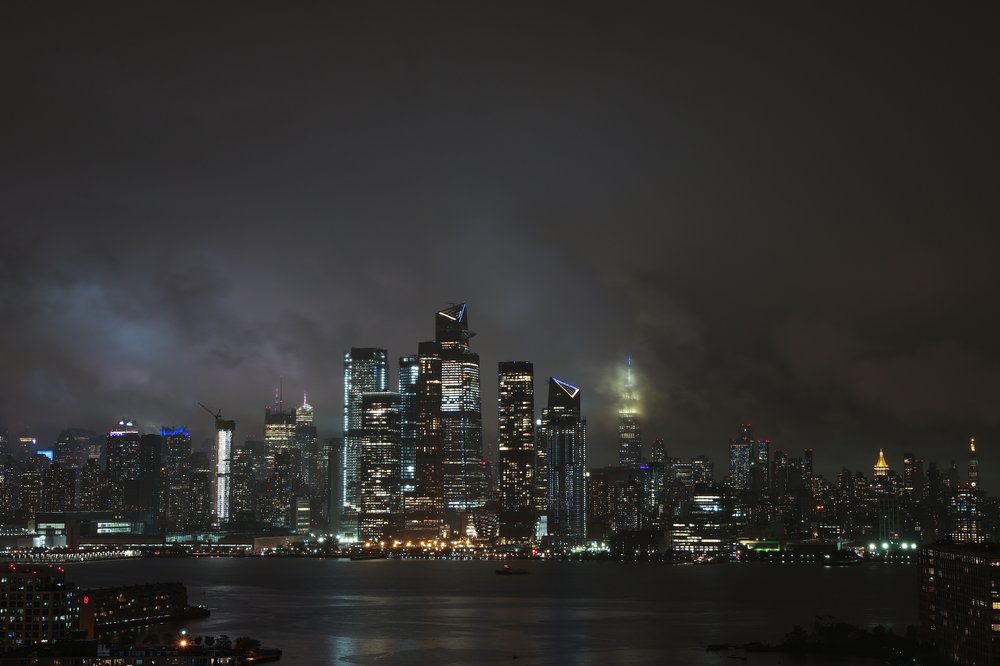This Earth Day, don’t forget to turn off your lights for International Dark Sky Week
April 22, 2022, 1:49 p.m.
April 22nd marks the start International Dark Sky Week, a reminder that light pollution has impacts on human health, animals, plants and climate change.

On a light pollution map, New York City shows up as a big white blotch.
With a surface brightness of about 17.5 magnitudes per square arc second, stars are very hard to see around the five boroughs. A nice dark sky — say in the middle of the ocean — measures at 22, making it easier to see stars. Places in upstate New York get close to this dark state. About 80% of North American residents can’t even see the Milky Way, which should be visible.
International Dark Sky Week aims to increase awareness of the seriousness of light pollution. It begins April 22nd, and runs through the end of the month.
Excessive and unnecessary artificial light does more than block the view of the universe; it impacts human health and wildlife. It also influences climate change. Light pollution continues to worsen at double the rate of population growth, and more than 80% of the world lives under bright lights.
“For all of human history, we've been able to walk out at night and look up at the stars and dream or imagine, and have a sense of something greater than ourselves,” said Dr. Paul Bogard, author of The End of Night: Searching for Natural Darkness in an Age of Artificial Light. “So, people tend to think just go somewhere dark if you want to see the stars, but there are a lot of other costs — environmental costs.”
Watch out for that skyscraper
New York City passed a law last year to turn off "non-essential" outdoor lights on municipally-owned buildings at night during spring and fall. The reason wasn’t to save energy, but to keep birds from colliding into windows.
Birds, mostly migrating at night, are attracted to the bright lights. They get confused, drawn off course and tired out. When too much light is present at night, birds can think it’s time to find food and a good place to rest for the next leg of their journeys because they think it’s day time. Instead, they end up flying right into building glass, and dying.
Approximately 90,000 to 230,000 birds die annually from building collisions in the five boroughs, according to estimates from the New York City Audubon Society. That’s because the metro area is on the Atlantic Flyway, one of the busiest flight paths for migratory birds.
“It’s true; I’m trying to get everyone to turn off their lights,” said Andrew Maas, spokesperson for the New York City Audubon Society. “The collective light from our city is drawing in all these birds, and the more light we can have turned off, the better it is for our birds.”
But birds are not the only ones affected by too much light at night. A Tufts University study reported last year that artificial light can suppress firefly mating. Females and males struggle to see each other’s flashing courtship signals in artificial lights, greatly inhibiting the creation of more fireflies.
Artificial light also draws moths, frogs and even sea turtles away from their natural habitats and into human areas, which can put these animals in dangerous situations such as becoming prey or getting trapped. Evening lights throw off many more aspects of animal health – from their sleep cycles to hormone levels. It can also reduce pollination, which affects plant reproduction.
Even life under water is affected. Plankton, migrate in the safety of evening waters to feed, so they can hide from fish, their predators. But light pollution disrupts these patterns.
Humans on too much light
Humans are not immune from their own bright shiny lights. Excessive brightness at night can cause insomnia. Secretion of melatonin — a hormone — is inhibited by light and is the primary driver of circadian rhythms. Light pollution has been associated with cancer, obesity and mental health problems, according to Dr. Joan Casey, an environmental health sciences professor at Columbia University’s Mailman School of Public Health.
“Light pollution can absolutely have implications for health,” Casey said. “Light at night can disrupt and desynchronize daily biological and behavioral rhythms, which can harm our health.”
The International Dark Sky Association, citing the U.S. Department of Energy, estimates the U.S. releases 21 million tons of carbon dioxide every year due to evening lights that are unshielded or left on while people aren’t around. Nationwide, at least 30% of evening outside lights are wasted, throwing away more than $3 billion annually. An estimated 875 million trees would have to be planted every year to offset the greenhouse gas emissions from this waste alone.
“Its [light] production is definitely associated with our go-go-go society, which produces large quantities of carbon emissions that drive climate change,” Casey said.
Experts said simply turning off the lights, inside and outdoors, especially if they’re unnecessary, is one way to tackle the problem. But there are plenty of necessary lights, such as street lamps.
In these instances, the lights should be pointed downward instead of skyward or horizontal. The lights should also be completely shielded.
But Bogard said that broader adoption of government ordinances, such as the one New York City passed to protect migratory birds, would go far in reducing light pollution.
“We have a whole lot of lights that are left on all night long for not any real good reason,” Bogard said. “At every level of every community, we can put in rules that say the next time we change the lights, let’s get it right. And that means lighting at the lowest levels possible.”